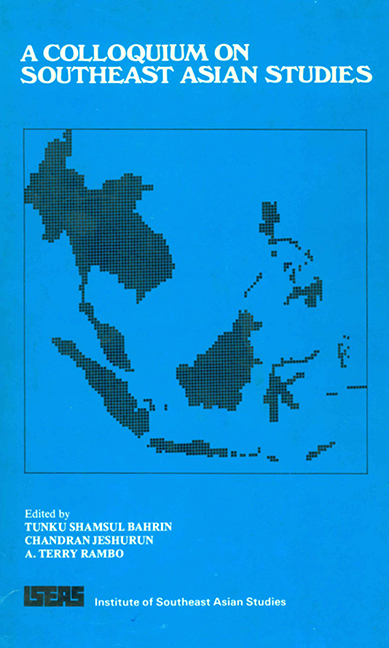Book contents
- Frontmatter
- Contents
- Foreword
- Preface
- Acknowledgements
- Introduction
- Contributors
- PART I TEACHING AND RESEARCH
- THE CONCEPTUAL THEORIES
- THE EXTRAREGIONAL EXPERIENCE
- THE REGIONAL PERSPECTIVE
- 8 Southeast Asian Studies in Indonesia
- 9 Southeast Asian Studies in Malaysia
- 10 Southeast Asian Studies in the Philippines
- 11 Southeast Asian Studies in Singapore
- 12 Southeast Asian Studies in Thailand
- THE PROBLEMS OF TEACHING AND RESEARCH
- PART II ENVIRONMENT AND DEVELOPMENT
11 - Southeast Asian Studies in Singapore
from THE REGIONAL PERSPECTIVE
Published online by Cambridge University Press: 21 October 2015
- Frontmatter
- Contents
- Foreword
- Preface
- Acknowledgements
- Introduction
- Contributors
- PART I TEACHING AND RESEARCH
- THE CONCEPTUAL THEORIES
- THE EXTRAREGIONAL EXPERIENCE
- THE REGIONAL PERSPECTIVE
- 8 Southeast Asian Studies in Indonesia
- 9 Southeast Asian Studies in Malaysia
- 10 Southeast Asian Studies in the Philippines
- 11 Southeast Asian Studies in Singapore
- 12 Southeast Asian Studies in Thailand
- THE PROBLEMS OF TEACHING AND RESEARCH
- PART II ENVIRONMENT AND DEVELOPMENT
Summary
Introduction
Singapore has traditionally had a vital interest in the affairs of Southeast Asian nations arising from the focal position the republic holds as the entrepot port for commerce between countries of Southeast Asia and the developed nations as well as its role as a communications and financial centre of the region. The republic's interest in the region has been stimulated by the presence of significant ethnic Chinese communities in all the countries in Southeast Asia where cultural and commercial ties have been to some extent maintained. More recently the establishment of the Association of Southeast Asian Nations (ASEAN) and the activities relating to political, cultural and economic cooperation have injected considerable interest in private and government bodies as well as in the academic community.
Academic Institutions
The University of Singapore (SU) and Nanyang University (NU) — now merged as the National University of Singapore — together with the more recently established Institute of Southeast Asian Studies (ISEAS) constitute the major strongholds of interest in Southeast Asian Studies. Apart from these, the South Seas Society established before the Pacific War represents a traditional focus of interest in the region's affairs on the part of the scholarly component of the Chinese community. The sections following will describe briefly the development of these institutions before dealing with their teaching and research activities.
The University of Singapore
The beginnings of the Republic's leading institution of higher learning, the University of Singapore, can be traced back to the King Edward VII College of Medicine which was first established as the Straits Settlements and Federated Malay States Government Medical School in July 1905 and subsequently changed to the King Edward VII Medical School in 1912. In 1921, the name was further changed to the King Edward VII College of Medicine after a period of substantial expansion. Quite separately, the Raffles College was established in 1929 primarily to train indigenous educators and civil servants. The Pacific War in 1942-1945 saw the closure of both institutions. However, they were reopened soon after the war.
- Type
- Chapter
- Information
- A Colloquium on Southeast Asian Studies , pp. 118 - 133Publisher: ISEAS–Yusof Ishak InstitutePrint publication year: 1981

